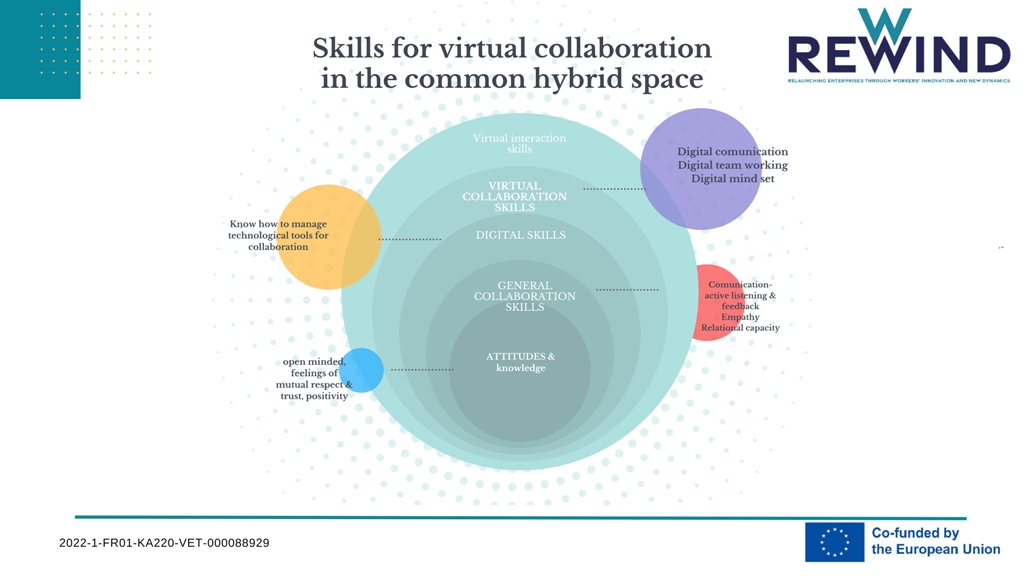What skills to develop in virtual teams?
External Resources
Dealing with Communication Challenges for Virtual Teams
The video illustrates the technological and digital tools that allow communication, coordination and collaboration, both in a synchronous and asynchronous work environment. The communication channels are different: video conferencing tools for online meetings, virtual whiteboards for brainstorming ideas, cloud-based document sharing platforms to centralize all files, and effective project management software.
The company must evaluate and identify the most suitable tools based on the people, projects and specific needs of the team to allow employees to interact and work together, regardless of where they are located. Each tool can be used strategically with a purpose and at a specific moment: to convince, inform, entertain, support and share.
How to Collaborate Effectively If Your Team Is Remote (The Explainer)
Technological tools facilitate digital communication, however, they do not magically solve all collaboration challenges and could even be used incorrectly.
For example: in the absence of nonverbal signals, it is often difficult to evaluate the progress of the relationship. If something starts to derail your relationship, you don’t have the benefit of informal office interactions to build rapport and re-establish trust. A conflict can cause the project to crash. Others perceive us differently. Remote communication requires a new set of protocols and behaviors illustrated in the video.
The key to remote collaboration is matching our digital tools to our communication goals, which means we need to know how to combine them. Many tips in the suggested video.
Building Traits of a Good Virtual Team Member
Virtual collaboration requires knowing how to manage complexity and uncertainty, knowing how to work towards objectives. It also requires you to use technical skills and a lot of interpersonal skills. The soft skill set concerns interpersonal skills that must be implemented for the distance and the medium.
Soft skills require an approach that is based on self-awareness, compassion and curiosity towards oneself, people and the world around them. In the video some indications on building the characteristics of a good virtual team member.
How to Become a Better Collaborator
Collaboration means putting your skills to work for the group to achieve a common goal together. You must be able to put your ego aside and make your own contributions to the group, because it is in the group that, as they grow, they become part of a common project.
It is important to listen and give feedback, contribute to discussions, solve problems or creative projects. It is in the exchange of ideas and opinions that the group is greater than its parts, which is why you need to be an active participant, especially from a distance! The inclusion of everyone is important and if the group is open and inclusive, it will be able to receive and welcome important ideas from outside as well. Remotely, some basic skills for good collaboration will have to be implemented and updated, others, such as autonomy, flexibility, intentionality, will have to be added.

How To Engage Remote Employees: 6 Ways To Get Virtual Teams Excited About Work
A risk of remote working is that the worker becomes detached from the company and becomes less motivated and therefore less productive. Collaborating with others requires commitment. There must be a culture of communication based on: Clear communication – Active listening to others – Taking responsibility for errors – Respect for the diversity of colleagues
The link considers some strategies to combat this distancing and make the working environment more inclusive even remotely. Encouraging and motivating remote teamwork is an indispensable resource, just as it is fundamental to foster a spirit of positivity within the group, the true key to success for a company.

5 proven strategies for efficient team collaboration
Competence is not just an activity but also a way of being and acting. Collaboration skills include the ability to communicate, listen, negotiate and build personal relationships. Developing collaboration skills is an essential element of employee engagement, not simply a preferred skill, and is closely linked to emotional intelligence.
Using these skills allows teams to find agreement, recognize each other’s contributions, and continue to collaborate effectively.

How to Improve Team Collaboration in 2024
Virtual collaboration requires you to implement both technical skills and soft skills. The solution lies in building a skillset that reflects the needs of our digital age.
Transversal skills for virtual collaboration put communication first, both oral and written, which includes the ability to listen and give feedback. Active listening will foster empathy and understanding of others, two interpersonal skills that are even more necessary when there are important filters such as the screen.
Transversal skills require a more nuanced approach than hard ones, because they are based on personal psychological resources: on self-awareness, compassion and curiosity towards themselves, people and the world around them.
Knowing how to understand others means giving space to others, and this happens with emotional intelligence and cultural intelligence, if we also collaborate with people of different ethnic origins.

How to Improve Your Soft Skills as a Remote Worker
This article informs you about how to apply the skills in group collaboration.
- Evaluate which soft skills you need to work on
- Create a development plan that includes activities that extend and engage different parts of your personality.
- Be curious, practice active listening, and take note of important details about your colleagues to show you’re paying attention.
- Proactively seek feedback to avoid missed opportunities for improvement that can be a consequence of virtual working.
Infographics
Skills for virtual collaboration in the common hybrid space

Test Yourself
Soft skills
Choose the correct statement for each question
Virtual communication
Virtual collaboration
Choose the correct answers. There could be more than one!
